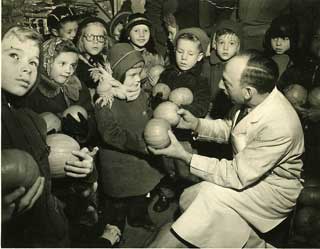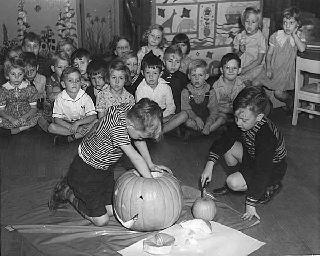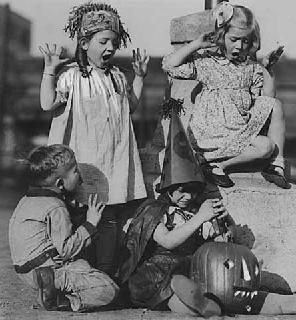Joseph S. Greenstein: the Pumpkin Man
"Pumpkin Joe" Greenstein, a grocer, was an icon in his north Minneapolis neighborhood. His son, Larry Greenstein, shared the story of how his father earned his title in his story, The Pumpkin Man.
Story Excerpts
For a brief moment I close my eyes and envision back to the early 1950s. I see Plymouth Avenue blocked off with literally thousands of pumpkins in the bushel baskets in the street. I see Mary Hartline of the kids' show "Super Circus" on a fire truck talking to the hundreds of children picking up their pumpkins. There are Minneapolis mayors there, PK Peterson or Eric Hoyer and I see horse-drawn carriages, goats, sheep pens and other novelties. It's "Pumpkin Day" in North Minneapolis.
Who is the Pumpkin Man?
If you ever lived in North Minneapolis, Pumpkin Joe Greenstein would need no introduction. He gained his moniker, the "Pumpkin Man" from his pumpkin distribution of the 1930s to the 1960s to North Minneapolis school children. He claimed, as a boy, he never could afford a pumpkin so he stole one. Thus, the children of North Minneapolis would always be provided with pumpkins.
Pumpkin Day Activities
A typical Pumpkin Day would begin early with farmers from Anoka, Champlin and other now-northern suburbs of Minneapolis dropping off their pumpkins for the distribution. The bushels would take up most of the east lane of Plymouth Avenue. For the rest of the day traffic would be diverted on Plymouth Avenue.
Novelties like livestock would then need to be put in place. Besides floats, carriages and animal pens, some of the more creative novelties included: a goat bathtub where goats would be bathed in confetti and a life-size replica of the "Sputnik" satellite (supposedly landing in North Minneapolis from Russia).
The press from television and newspapers would be on hand as the distribution began. Dozens of Jefferson and Greyhound Lines buses would donate their services transporting children to and from the grocery store. Children would go through the rows of pumpkins looking for a choice Jack O'Lantern. Always in attendance was a television personality children could recognize. Usually a politician or two would also make an appearance.
Pumpkin Day Faces Challenges
Loads of pumpkins were sent directly to various schools not making the trip to the store. In all, in any given year, several thousands of pumpkins were given out by the Pumpkin Man.
My father told me the only years there were no Pumpkin Days were during World War II. A sign was placed on the grocery store door stating "Store closed. Off to fight the war." At that point, he was still leasing the property and rent was paid throughout the war to maintain the lease.
In the early 1960s, after being approached by the highway department, my father could read the handwriting on the wall. He either needed a new location or a new line of work. Friends encouraged him to run for the 5th Ward Alderman seat in North Minneapolis. He did and served five consecutive terms during some very trying times in the 1960s.
The End of Pumpkin Day
The last Pumpkin Day was held in 1965. The store was gone and a delapidated house was decorated into a haunted house for the giveaway. Soon the whole neighborhood was torn down and the massive highway project began. What was the Blaine School neighborhood and St. Joseph's Parish Community and points north vanished.
Pumpkin Joe died in 1980. Times change, people change, cities change. I'd like to say there is some lasting monument to the memory of this very generous and public man somewhere in North Minneapolis. If anyone asks, I direct them to that pillar that supports Highway 94 and sits at 327 Plymouth Avenue North. Close your eyes. You might see a lot of pumpkins.





Source
Greenstein, Larry, The Pumpkin Man. Minnesota Historical Society: Share Your Story


